American middle class slowly disappearing under mounds of debt – How Wall Street and government sucked working and middle class Americans into perpetual debt serfdom.
- 9 Comment
People quickly forget about the nearly 1,000 point “flash crash†brought on by glitches in the Wall Street casino machinery. Still no sensible explanation has been given but today the stock market now stands below the flash crash moment. The middle class is witnessing the largest wealth transfer in history take place and it is all happening because of the Wall Street infrastructure and the government’s lack of respect for the working class of the United States. Even last month as we lost 125,000 workers the unemployment rate actually went down because over 500,000 Americans simply dropped out of the workforce. In other words people simply threw their hands up in exhaustion and gave up. The government is literally not counting tens of thousands of Americans. What does this tell you about how much they value the middle class?
Let us break down some income data first:
47 percent of American households make less than $50,000 a year. 66 percent make less than $75,000. This should give you a sense of the household income in the U.S. Only 4.3 percent of U.S. households make more than $200,000. Income for working and middle class Americans has remained stagnant for one agonizing decade. What has occurred over this time is the artifacts of a middle class lifestyle like a decent home and a college education have been juiced with massive amounts of banking debt. As banks have tried to put their hands on every aspect of American life, prices have zoomed up in every industry they have jumped into. Look at housing and higher education for dramatic examples. 50 years ago most middle class Americans could afford a college education and a starter home without sacrificing every single penny to servicing debt.
Debt has engulfed our nation. If we look at personal consumption as a percent of GDP we can start seeing where problems started:
Personal consumption makes up over 70 percent of our GDP. Banks love using this figure to beat on middle class Americans to blame them for the problems in the current recession. Keep in mind that the above chart also includes giant increases in health care costs and also, large piles of cash going to service debt that banks are so happy to take. Yet the above point of the chart does hold steady. That is, we have gone from producing to spending too much as a nation. It is fun while things are good but is definitely unsustainable. And don’t think this spending came from actual savings:
The drop in personal savings is incredible. As we went negative for a short period of time, banks were capitalizing by allowing people to spend more money than they actually had. If we look at the trillions of dollars given out to banks that made poor bets in the last decade, we’ll see that they are also the largest players in the credit card game:
Source:Â Reuters
The above chart is basically the too big to fail. They have fed massive amounts of credit cards into the system with little due diligence since they knew in the end, taxpayers would bail them out. Now that things have gotten bad (not for too big to fail banks since they have gotten the ultimate gold plated bailouts) they are now crunching down on the middle class. High interest charges, onerous fees, and other trickery are merely ways of sucking real wealth from those who work to a class that is largely unproductive and has led us into this economic predicament.  The government has worked hand in hand with the banks here.
Credit card debt eats up a large portion of annual household income for millions:
Much of what we consider to be middle class living has been kept on life support by banking debt. Yet no system can go on forever with too much debt and too little production. Banks have become a dangerously large part of our economy. That is why so much focus is given to Wall Street and the banking sector. It is a largely idle industry that merely attempts to suck off the wealth creation of actual real work. The housing bubble was the pinnacle of banking neurosis. The idea that you can simply repackage toxic mortgages into “sophisticated†debt products and sell them off as diamonds to unsuspecting fools is appalling. Yet in most cases, all this was legal because our Senators write the laws that should be protecting us. Instead, they have allowed Wall Street to control every aspect of finance and now here we are with 40 million Americans on food assistance and a close to 17 percent unemployment and underemployment rate. Yet things are getting better for the middle class?
The current system is not capitalism but a form of state sponsored cronyism for banks. Most of us can understand that if you have a good product then by all means make a profit. This is the essence of any small business and their survival. But the banking system operates under perverse rules. They created inordinate amounts of debt products that serve no purpose and assured destruction of those taking on the product. Think of option ARMs that actually grew the balance of the mortgage! Horrible products that have destroyed large portions of the real economy and have pushed many off the middle class path. How many foreclosures could have been avoided over the past decade with more prudent banking? Yet this isn’t what the system wants. Banks wouldn’t mind if all you did was work and had to open your beat up leather wallet and pull out 99.99 percent of your net pay to service your debt. In fact, this is probably their ultimate wish.
Where do people spend their money?

Source:Â BLS
Housing by far is the largest line item above. Yet categories like medical care and education are growing at rates that outpace the overall rate of inflation. Ironically these are areas that are favorites of Wall Street. As long as you can slap a loan onto something, the big investment banks will be there drooling over every penny they can tack on.
There was a time when paying off your mortgage was a good thing. We have a good number of Americans who own their home mortgage free:
Over 30 percent of homeowners in the U.S. own a home with no mortgage. Yet these are typically people from an era that allowed them to pay down their mortgage even with a modest income. How likely is it that someone in say a state like California who bought a home at $500,000 with a $70,000 income is going to pay off that home? They’re not going to do it so that is why in the chart above you see distress levels off the charts.
Even if we look at current metrics for 3 of the largest states, we find that debt is not necessarily a good thing:
California and Florida both had major home price appreciation and relied heavily on the housing bubble. Both areas have seen bubbles pop. The difference however is that Florida prices have come down to more reasonable levels. California prices are still too high. A reasonable metric is 3 times annual household income for home prices (both Texas and Florida are close to that range). California is still out of that range. So why are economic problems still deep? Because current income data will be lower when Census data comes out in September and that is not reflected above.
The ability for Wall Street to turn many things into a commodity has allowed them to gamble and speculate on the well being of middle class Americans. Housing prices would not have gone into a massive bubble without banks pushing other people’s money out the door. Wall Street is good at taking risk when their money is not at stake. They are fine taking the biggest risk since they know the U.S. taxpayer will be on the hook eventually for their irresponsible decisions with a large safety new. Do you think banks would have loaned out of their own treasury like they did if it was their money on the table? Of course not. Yet if something isn’t changed then middle class Americans are going to find it harder and harder to stay afloat while debt starts coming down over them like a tsunami.
It is time to break the chains from the Wall Street banks. Split them up. There is no need to have commercial and investment banking comingled. The banking needs for most Americans are simple. Why mix it up with banks that now operate like hedge funds and take needless risk? If there is no change, people are going to start seeing more and more of their paycheck going to servicing debt and guess who ends up with that money in the end?
If you enjoyed this post click here to subscribe to a complete feed and stay up to date with today’s challenging market!9 Comments on this post
Trackbacks
-
CompassionateFascist said:
Revealing piece on role of banksters in destroying U.S. middle class. Structural factors equally important: “free trade” racket exporting MC jobs to foreign sweatshop economies; and open-borders immigration racket (legal and illegal) drowning working-class in so much cheap labor as to make impossible any rise into the middle class. All this, of course, is occurring for one reason: globalization. The globalistas – multinational corps., banksters, demican-republicrat pols, etc. – know that they cannot take down the nation(s) until they root out nationalism. And historically, the rise of the modern nation-state – U.S. and others – went hand in hand with the rise of the middle class. Whether they get with it is, of course, another question. Looks like the debt bombs are going to go off before they do, and a good thing too.
July 5th, 2010 at 8:29 pm -
JBPeebles said:
Excellent post. I’d seen some of these facts before but the charts assembled here characterize the problems the middle class are facing.
It’s impossible not to imagine a political agenda here. Historically, revolutions have been started by the middle class as the peasants and lower classes are simply struggling to survive.
With fewer resources, more debt, and unreliable income, the middle class is being subjected to what I call povertization. It’s hopeful to think Americans can build an emergency fund to avoid the certain cash shortages that await. Once that’s in place, it’s possible to participate in the stock markets as an investor. (Contrary to the author, I consider some kinds of insurance and mutual fund sales direct to the public as hard work, even if the “idle” Wall Street people are part of Fitts’ “Tapeworm Economy.”)
Get the public investing again like the 90’s and the middle class can do better. Yet to get to the point more people can invest, they need to reduce consumption, which of course hurts the economy. And they need jobs, which requires protection from unfair competition and lax enforcement of regulatory standards abroad.
A measured increase in spending, within one’s means, can boost the economy. Investing domestically (or even better, locally) can have a good impact. Meanwhile one has to protect one’s investments with precious metals, although investing in them puts few fellow Americans to work compared to buying shares. Your money needs to stay local to work effectively, so avoid chain restaurants, Fast Food, and Big Box retailers when you can. The reduction in consumption of bad and unnecessary things can be a good thing…as a matter of fact, lowering consumption will be the chief benefit of hard times being forced upon us.
See also a Richard Wolff video here (courtesy whatreallyhappened.com):
http://femalefaust.blogspot.com/2010/06/2007-fact-six-leave-from-minot-minus.html#war-on-usJuly 5th, 2010 at 8:50 pm -
liberalpatriot said:
tennessee earny ford said it best,”16 tons whata ya get another day older and deeper in dept….so i owe my soul to the company store…” they just went up market from the coal fields where i worked so well for so many years….and now it is in the form of plastic cards we use like money and you know the rest or you were in cryogenic hibernation for the past fifty years
July 6th, 2010 at 8:46 am -
tim leery said:
“Claw back” collect a bonus if based on fraud. REturn the
bonus to taxpayers.July 6th, 2010 at 12:51 pm -
sharonsj said:
According to Elizabeth Warren, the mound of debt is because both husband and wife must work in order to pay the bills. Should either one get sick or get fired, the family is screwed. And who can we thank for this? Mostly Republicans, who have the nerve to talk about family values, and corporatist Democrats. They have allowed the credit card companies to hand out numerous cards to every American and to charge usurious rates. Nothing will change unless we march on Wall Street and Washington D.C.
July 6th, 2010 at 3:23 pm -
liberalpatriot said:
heres i handled it when my ex wife went wild with the credit cards…i cut them all in tiny pieces and melted them into nice christmas tree…best christmas we ever had….three years later we paid off all the vultures and i have been using the junk credit card mail as tender for the fire place….my credit is in the dumper but i don’t care….i will pay for everything with cash, check or debit card….no more bottomless pit of debt
July 9th, 2010 at 8:06 am -
The Arthurian said:
Good post. Hey, I’m gonna borrow the Grandfather Economic Report graph… and your PCE-relative-to-GDP graph…
RE: Your five sentences — “Much of what we consider to be middle class living has been kept on life support by banking debt. Yet no system can go on forever with too much debt and too little production. Banks have become a dangerously large part of our economy. That is why so much focus is given to Wall Street and the banking sector. It is a largely idle industry that merely attempts to suck off the wealth creation of actual real work.”
Yes, yes, yes, yes, and hold on a moment. I prefer to think of finance not as “a largely idle industry” but rather as the facilitative sector of the economy. Adam Smith’s factors of PRODUCTION included land, labor, capital. To these we must add finance as the FACILITATIVE factor. (Sound good to you, Peebles?)
But you are right, mybud, when finance becomes too big, production becomes too small. When finance drains profit from the productive sector, people invest more in finance and the problem only gets worse. Etc, etc.
U.S. monetary policy restricts the growth of non-credit money in order to fight inflation. U.S. fiscal policy encourages spending and the use of credit in order to stimulate the economy. Combined, these policies have turned us into credit-users. We use credit for money. You know, “in the form of plastic cards we use like money” as liberalpatriot says. That’s why we’re buried in debt.
The solution is not to cut spending or any of the solutions like that, that you hear every day. The solution is to start using accelerated repayment of debt as a way to fight inflation. Instead of monetary restriction by the Federal Reserve. For starters.
Good post.
July 9th, 2010 at 3:39 pm -
NOTaREALmerican said:
Could you expand on the “savings rate” concept sometime.
Re: And don’t think this spending came from actual savings:
It seems the term “savings” has multiple meanings. I now hear that Americans are “saving more” but I sure don’t know anybody (other than myself) that is saving anything now (I’ve always been a “saver”). I also hear about a “shift in behavior toward savings”, which I find laughable.
The graph you show reflects my impression of most of America, which has been not to save since the ’80s.
July 15th, 2010 at 10:14 am -
Joe I.T. said:
Back in the 80’s when we as a nation started the big debt borrowings under Reagan, we were warned about individual AND national debt dangers.. (remember the Grace Commission anyone?)
A number of our friends lived a lot better than us, while we kept our budget pretty lean – the old-fashioned idea “when you don’t have the money you do without” except for the home and car loans.
Now its paying off. We are not rich, but what we have is ours.
July 16th, 2010 at 7:30 am
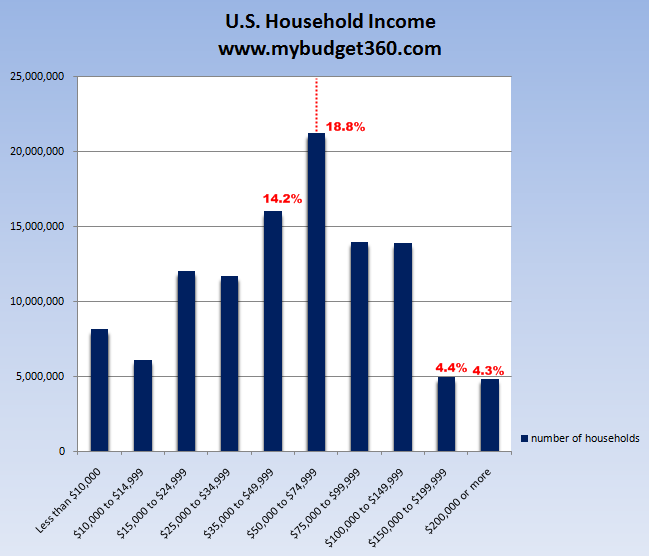
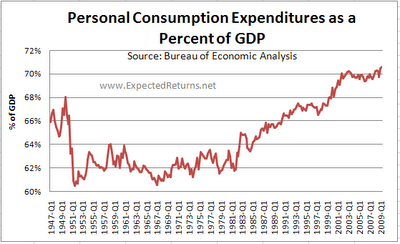
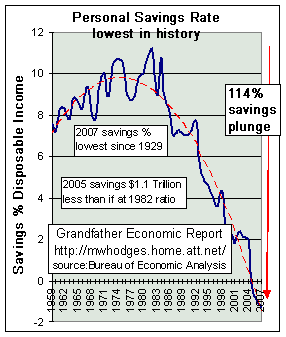

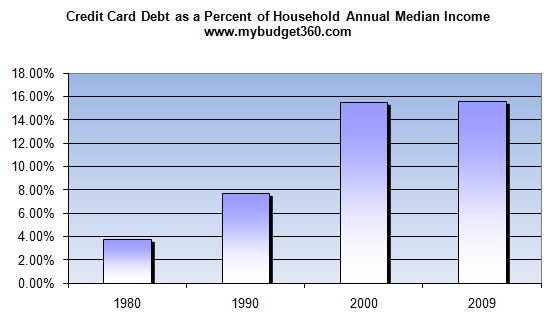
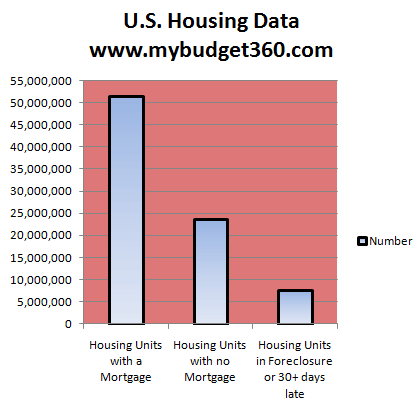

 If you enjoyed this post click here to subscribe to a complete feed and stay up to date with today’s challenging market!
If you enjoyed this post click here to subscribe to a complete feed and stay up to date with today’s challenging market!